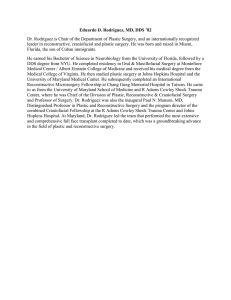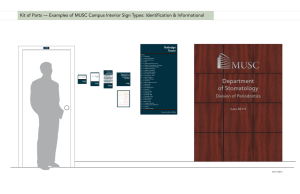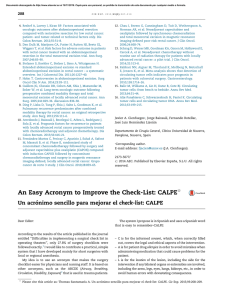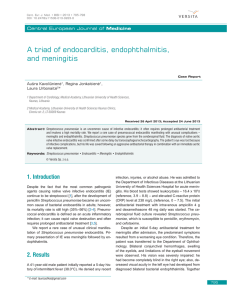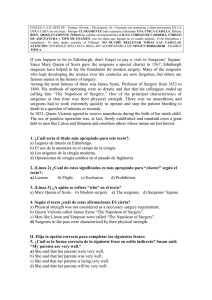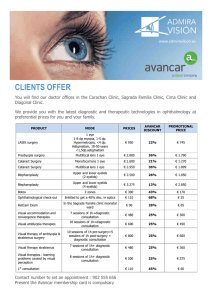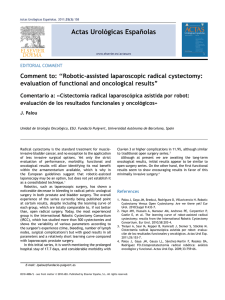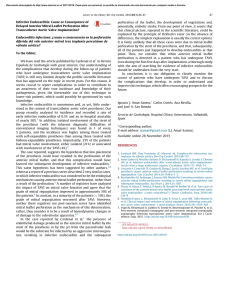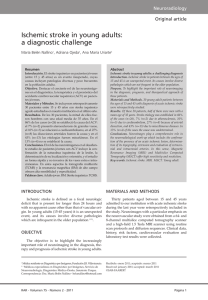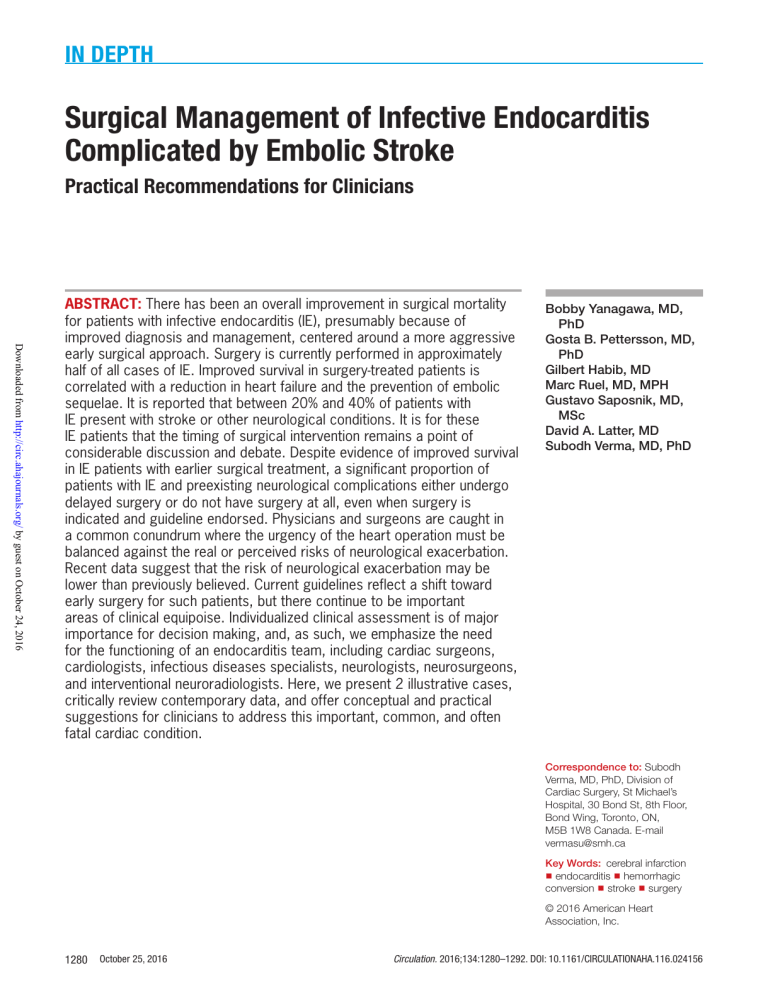
In Depth Surgical Management of Infective Endocarditis Complicated by Embolic Stroke Practical Recommendations for Clinicians Downloaded from http://circ.ahajournals.org/ by guest on October 24, 2016 ABSTRACT: There has been an overall improvement in surgical mortality for patients with infective endocarditis (IE), presumably because of improved diagnosis and management, centered around a more aggressive early surgical approach. Surgery is currently performed in approximately half of all cases of IE. Improved survival in surgery-treated patients is correlated with a reduction in heart failure and the prevention of embolic sequelae. It is reported that between 20% and 40% of patients with IE present with stroke or other neurological conditions. It is for these IE patients that the timing of surgical intervention remains a point of considerable discussion and debate. Despite evidence of improved survival in IE patients with earlier surgical treatment, a significant proportion of patients with IE and preexisting neurological complications either undergo delayed surgery or do not have surgery at all, even when surgery is indicated and guideline endorsed. Physicians and surgeons are caught in a common conundrum where the urgency of the heart operation must be balanced against the real or perceived risks of neurological exacerbation. Recent data suggest that the risk of neurological exacerbation may be lower than previously believed. Current guidelines reflect a shift toward early surgery for such patients, but there continue to be important areas of clinical equipoise. Individualized clinical assessment is of major importance for decision making, and, as such, we emphasize the need for the functioning of an endocarditis team, including cardiac surgeons, cardiologists, infectious diseases specialists, neurologists, neurosurgeons, and interventional neuroradiologists. Here, we present 2 illustrative cases, critically review contemporary data, and offer conceptual and practical suggestions for clinicians to address this important, common, and often fatal cardiac condition. Bobby Yanagawa, MD, PhD Gosta B. Pettersson, MD, PhD Gilbert Habib, MD Marc Ruel, MD, MPH Gustavo Saposnik, MD, MSc David A. Latter, MD Subodh Verma, MD, PhD Correspondence to: Subodh Verma, MD, PhD, Division of Cardiac Surgery, St Michael’s Hospital, 30 Bond St, 8th Floor, Bond Wing, Toronto, ON, M5B 1W8 Canada. E-mail [email protected] Key Words: cerebral infarction ◼ endocarditis ◼ hemorrhagic conversion ◼ stroke ◼ surgery © 2016 American Heart Association, Inc. 1280 October 25, 2016 Circulation. 2016;134:1280–1292. DOI: 10.1161/CIRCULATIONAHA.116.024156 Surgery for Endocarditis and Stroke T Circulation. 2016;134:1280–1292. DOI: 10.1161/CIRCULATIONAHA.116.024156 Table 1. Neurological Sequelae of Infective Endocarditis and Approximate Proportion Complication Approximate Proportion Reference Snygg-Martin et al14 Ischemic stroke Cooper et al13 70% Barsic et al15 Thuny et al16 Ting et al17 Intracerebral hemorrhage Derex et al18 10% Diab et al19 Garcia-Cabrera et al11 Okita et al10 Subarachnoid hemorrhage 5% Meningoencephalitis Sonneville et al20 5% Garcia-Cabrera et al11 Lucas et al21 Intracerebral abscess Infectious intracranial aneurysm Encephalopathy 5% Garcia-Cabrera et al11 Sonneville et al20 5% Peters et al22 – Garcia-Cabrera et al11 or further embolization from cardiopulmonary bypass, and diffuse cerebral ischemia from altered vasoregulation, as well (Figure 1). The indications for urgent surgery include severe heart failure, unresponsive or poorly controlled infection, highly virulent and resistant organisms, perivalvular extension or abscesses, development of heart block, prosthetic valve infection with unstable prosthesis, recurrent embolism, and large vegetation(s) associated with imminent risk of embolism. Regarding this latter point, there are established risk factors related to infective agent, vegetation size, mobility, and location and history of embolism that place a patient at higher risk of further embolism based on observational data (Table 2).18,25–33 On the other hand, it has been reported that the risk of stroke falls once antibiotic therapy has been established.34 Although surgical timing should be individualized and decided with input from multiple specialists, we believe more patients could benefit from early surgery. Despite emerging trends in the recent literature that can help to guide this decision, currently, a significant proportion of patients with IE and neurological complications (eg, ischemic stroke) and a cardiac indication for surgery either have their operation delayed or not performed at all.11 In this review, we discuss the neurological complications seen in IE patients and present the contemporary October 25, 2016 1281 STATE OF THE ART Downloaded from http://circ.ahajournals.org/ by guest on October 24, 2016 he overall outcomes of patients with infective endocarditis (IE) are improving possibly because of a more proactive, earlier surgical approach.1 Surgery is currently performed in approximately half of all cases of IE and is correlated with clinical benefits from improving heart failure and preventing embolic sequelae.2 Furthermore, earlier surgery may confer a survival benefit.3–5 In a propensity-matched analysis of patients with IE that underwent early surgery versus medical therapy, early surgery was associated with an impressive reduction in mortality (absolute risk reduction, 5.9%; P<0.001). A recent meta-analysis of 21 studies confirmed a survival advantage for early surgery (<7 days) for unmatched (odds ratio [OR], 0.61; 95% confidence interval, 0.50–0.74; P<0.001) and propensity-matched cohorts (OR, 0.41; 95% confidence interval, 0.31–0.54; P<0.001).5 In the only prospective randomized trial in this field, Kang et al3 compared early surgery (<48 hours) versus conventional management in patients with uncomplicated left-sided IE, vegetation >10 mm, and severe valvular disease. Early surgery was associated with a reduced composite end point of all-cause mortality and embolic events (hazard ratio, 0.10; 95% confidence interval, 0.01–0.82; P=0.03), driven by lower systemic embolism. Similar findings were shown in a prospective study of critically ill patients with IE and neurological injury, although there likely was selection bias.6 These studies support an emerging consensus that, for the majority of IE patients, once there is an indication for surgery, there is little benefit in delaying the operation. Rather, delay carries the potential for harm from worsening heart failure, repeat embolic events, and even death. The predominant cerebral insult from septic emboli is ischemic stroke, but may also include intracerebral hemorrhage, either subarchnoid or subdural hemorrhage, infectious aneurysm, brain abscess, and rarely meningitis (Table 1).7–22 As many as 40% of patients with IE present with clinically evident neurological sequelae, but brain MRI of IE patients has identified embolic lesions in as many as 60% to 80% of patients.13,14,23,24 A retrospective series of 102 patients with IE found clinical neurological deficits in 34%, but demonstrated lesions in 63% by diffusion-weighted imaging MRI.7 Similarly, in a series of 56 patients with IE, clinical stroke was diagnosed in 25%, but evidence of embolization was identified by MRI in 80% of patients.13 Because cerebral embolic events pose an independent risk factor for mortality in IE, even subclinical neurological injury may have prognostic importance.6 The decision on surgical timing in patients with IE and neurological injury requires a balance between the urgency of the operation for cardiac indications versus the perceived risk of exacerbation of neurological injury by intracerebral hemorrhage, hypotension, Yanagawa et al Downloaded from http://circ.ahajournals.org/ by guest on October 24, 2016 Figure 1. Conceptual diagram of arguments for early and delayed surgery in patients with infective endocarditis with stroke and other cerebral complications. data that inform the optimal timing of surgery. This document seeks to expand on the recent guidelines by the American Heart Association (AHA), European Society of Cardiology/European Association for Cardio-Thoracic Surgery/European Association of Nuclear Medicine, and the Society of Thoracic Surgeons (Table 3).31,35,36 Thus, the development of the present document involved a comprehensive literature review based largely on recent observational trials, and review and specific adaptation of recent AHA, European Society of Cardiology, and Society of Thoracic Surgeons guideline statements, as well. In the next sections, we illustrate 2 cases of surgical management of IE and embolic stroke that reflect the range of clinical presentation and challenges in decision making in these patients. Our recommendations, however, are based on evidence in case series, cohort studies, and meta-analysis, not only by these illustrative cases. CASE 1 A 70-year-old patient was referred for a Streptococcus mitis infective endocarditis of the aortic valve. Transesophageal echocardiography showed a perforated aneurysm of the left coronary cusp with massive aortic insufficiency and a large vegetation (Figure 2A). Eight hours after admission, he presented with an ischemic stroke manifested by dysarthria and right hemiparesis. 1282 October 25, 2016 Brain MRI showed a hyperintense lesion of the left frontoinsular area without mycotic aneurysm (Figure 2B; MRIfluid-attenuated inversion recovery and MR angiogram). Computed tomography (CT) scan confirmed the ischemic lesion without hemorrhagic conversion (Figure 2B; CT scan). 18F Positron emission tomography (PET) demonstrated uptake in the ischemic area (Figure 2B; PET-CT). Although the patient improved clinically, repeat preoperative CT scan at day 7 revealed hemorrhagic conversion of the ischemic lesion (Figure 2C, white arrow), which delayed the planned valvular surgery for 3 weeks to ensure stability of the hemorrhagic conversion by weekly CT scan. Intraoperatively, the valvular lesion was confirmed (Figure 2D) and bioprosthetic aortic valve replacement (25 mm Edwards Lifescience Perimount) was performed without cerebral complication. This case illustrates a comprehensive neurological evaluation and surgical timing that was based on serial neurological imaging. CASE 2 A 39-year-old patient with a history of aortic valve replacement and pacemaker implantation and reoperation for fungal (Aspergillus species) prosthetic valve endocarditis 6 months previously presented with recurrent fungal endocarditis with large vegetations in the Circulation. 2016;134:1280–1292. DOI: 10.1161/CIRCULATIONAHA.116.024156 Surgery for Endocarditis and Stroke Table 2. Risk Factors for Embolism in Left-Sided Infective Endocarditis Risk Factors Vegetation size >10 mm or >13 mm Reference Wilbring et al25 Rizzi et al26 Mylonakis et al27 Mugge et al28 Vilacosta et al29 Thuny et al30 Vegetation mobility Thuny et al30 Infective agent: Staphylococcus aureus Derex et al18 Baddour et al31 Rizzi et al26 Thuny et al30 Infective agent: fungal Location: anterior mitral valve > aortic valve Thuny et al30 Baddour et al31 Derex et al18 Rohmann et al32 Anderson et al33 Prior history of embolism – proximal aorta and small vegetations on the prosthetic valve (Figure 3A and 3B). He embolized to the lower extremities requiring emergency embolectomy. A CT scan of the head revealed multiple 6- to 7-mm infarcts (Figure 3C and 3D) including one with hemorrhagic conversion (Figure 3D) and 2 smaller mycotic aneurysms (the larger embolized just before her heart operation) (Figure 3E1 and 3E2, with Glue Cast). The risk of additional embolization was considered very high, justifying urgent cardiac surgery despite a perceived high risk of complications, including exacerbation of cerebral hemorrhage. A multidisciplinary endocarditis team agreed to the urgent timing of the operation. Intraoperatively, the aortic vegetation was predominantly found at the previous aortotomy, which had been repaired with pledgets and bovine pericardium. The prosthetic aortic valve itself had minimal vegetations. Complete debridement and homograft root replacement were performed. The pacemaker leads in the right atrium were not convincingly infected but leads and pacemaker were removed. Specimens identified Aspergillus terreus, resistant to Amphotericin B. The postoperative course was uneventful with stable neurological symptoms and followed up with serial brain imaging. The patient was treated with 6 weeks of intravenous antifungals and, at 2 years, the patient is doing well. This case illustrates that early surgery can be performed successfully even in the setting of multiple small cerebral infracts, including one with hemorrhagic extension. Circulation. 2016;134:1280–1292. DOI: 10.1161/CIRCULATIONAHA.116.024156 Ischemic stroke attributable to septic embolism is the most common neurological complication with IE. Early studies demonstrated higher mortality with surgery in IE patients with neurological signs in the acute period following ischemic stroke.9,37–39 A multicenter Japanese study of 181 patients with cerebral complications with IE reported neurological deterioration in 44% of patients when surgery was done between 2 and 7 days, 16.7% for surgery between 1 and 2 weeks, and 2.3% for >4 weeks after the neurological injury.9 Furthermore, mortality was greater for patients having early surgery in comparison with between 1 and 2 weeks and >4 weeks (44%, 17%, and 7%, respectively). Angstwurm et al39 in 2004 reported that the risk of neurological exacerbation with surgery was 20% when surgery was undertaken within 3 days of presentation, 20% to 50% between 4 and 14 days, but <10% when surgery was performed >14 days and <1% when surgery was performed >4 weeks after an embolic event. Interpretation of this last finding is challenging, because significant treatment selection bias was present, because those patients undergoing surgery had greater hemodynamic compromise and ongoing sepsis, thus representing a higher-risk cohort. Furthermore, most observational series have lacked clinical imaging data to determine the extent of stroke, the causative bacterial organism, and the size, mobility, and location of vegetation, all of which should influence surgical timing and outcome. Despite these limitations, these and other early studies, which showed that delay in surgery was correlated with better outcomes, had an important influence on the early guidelines. MORE RECENT STUDIES ON THE IMPACT OF EARLY SURGERY ON OUTCOMES Important evidence from several more recent observational studies demonstrates that the overall risk of hemorrhagic conversion and mortality may be lower than previously reported.40,41 When propensity matching is performed to adjust for inherent selection biases, risk is no longer significantly greater with early surgery.7,8,42,43 Piper et al42 in 2001 suggested that surgery can be performed with low risk within a 72-hour window of the neurological insult. A retrospective review by Morita et al43 of 253 patients with IE with ischemic stroke found no difference in overall mortality (8.6% versus 9.5%) and perioperative complications (42.9% versus 37.8%) between unmatched early (<7 days) and delayed (>7 days) surgery cohorts. The propensity-matched analysis confirmed no difference between groups. In the unmatched comparison, there was a nonsignificant higher risk of cerebral hemorrhage in the early surgery group (6.7% October 25, 2016 1283 STATE OF THE ART Downloaded from http://circ.ahajournals.org/ by guest on October 24, 2016 Infective agent: Streptococcus bovis EARLY STUDIES OF ISCHEMIC STROKE AND SURGICAL TIMING Yanagawa et al Downloaded from http://circ.ahajournals.org/ by guest on October 24, 2016 Figure 2. Aortic valve infective endocarditis and stroke with hermorrhagic conversion. Aortic valve vegetation by TEE (A), left frontoinsular infarct by brain MRI (B; MRI-Flair and AMR), CT scan (B; CT-scan), and 18F positron emission tomography (B; PET-CT). Hemorrhagic conversion on follow-up CT scan (C; white arrow). Intraoperative valvular lesions (D). AMR indicates magnetic resonance angiography; CT, computed tomography; FLAIR, fluid-attenuated inversion recovery; PET, positron emission tomography; and TEE, transesophageal echocardiography. versus 2.0%, P=0.1), but this was not found in the propensity-matched analysis. In a recent retrospective Japanese multicenter study of 568 IE patients (n=118 with ischemic stroke and n=54 with hemorrhagic stroke), in the ischemic stroke group, delaying surgery between 2 and 4 weeks and >4 weeks resulted in a trend to a higher incidence of hospital death (OR, 5.90; P=0.107 and OR, 4.92; P=0.14) in comparison with early surgery within 7 days.10 The International Collaboration on Endocarditis-Prospective Cohort Study (2013) included 4794 patients with IE, of which 857 (17.9%) had an ischemic stroke and only 198 (23%) underwent cardiac surgery.15 The propensity-matched analysis found that early surgery correlated with a nonsignificant trend of increased in-hospital (OR, 2.3; 95% confidence interval, 0.94–5.7) and 1-year mortality (27.1% versus 19.2%, P=0.3). Thus, more recent studies, including those with propensity-matched analyses, have not found a significant increased risk of mortality or neurological exacerbation for early surgery in patients with ischemic stroke sec- 1284 Circulation. 2016;134:1280–1292. DOI: 10.1161/CIRCULATIONAHA.116.024156 October 25, 2016 Surgery for Endocarditis and Stroke CT indicates computed tomography; and TEE, transesophageal echocardiography. ondary to IE. However, when interpreting these data, we need to be aware of the era. Contemporary outcomes have improved because of a trend toward early surgery guided by improved brain imaging. With earlier surgery, the patient is less likely to sustain additional embolization while awaiting surgery. It is our opinion that, on balance, more patients with IE and ischemic strokes should be considered for earlier surgical intervention. RISK OF NEUROLOGICAL EXACERBATION Because cardiopulmonary bypass requires high-dose anticoagulation, concerns have long been raised about the risk for hemorrhagic conversion of ischemic stroke, or exacerbation of small hemorrhage, when early surgery for IE is performed in patients with cerebral embolism. The true impact of heart surgery on neurological status and lesions is difficult to address, because few series have measured the extent of cerebral injury with MRI Circulation. 2016;134:1280–1292. DOI: 10.1161/CIRCULATIONAHA.116.024156 October 25, 2016 1285 STATE OF THE ART Downloaded from http://circ.ahajournals.org/ by guest on October 24, 2016 Figure 3. Aspergillus endocarditis with large fungal vegetations in a dilated ascending aorta on the old aortotomy suture line (arrows) seen by TEE (A) and CT scan (B), brain infarct by CT scan (C and D, arrows), and mycotic aneurysms (E1 and E2). before and after surgery. In an observational study of 102 patients with IE and cerebral embolism, 34 patients underwent early surgery (mean, 4.1±4.2 days) and 30 patients underwent delayed surgery (mean, 34.2±17.1 days).7 There were no differences in the maximum size (18.3±21.4 mm versus 21.2±19.4 mm) and number of infarcts (2.9±1.7 versus 2.8±2.0) between those that had early and delayed surgery. The incidence of neurological exacerbation was lower in patients that underwent early surgery (35.3% versus 73.3%, P=0.003). In comparison with hemorrhagic conversion rates of 20% to 50% in older series, more recent studies suggest rates of <10%.7,8,16,17 Yoshioka et al7 report a 2% overall hemorrhagic conversion rate, whereas Rutmman et al8 found only 1 patient with hemorrhagic conversion among 65 patients with ischemic strokes undergoing surgery. Collectively, these reports using comprehensive neurological imaging confirm that patients with ischemic embolic strokes secondary to IE have a more favorable prognosis with early surgery and a much lower risk of hemorrhagic conversion of ischemic infarcts than previously reported. In the general stroke population, the baseline incidence of spontaneous hemorrhagic conversion for all strokes ranges from 38% to 71% in autopsy studies and from 13% to 43% in CT studies, whereas the incidence of symptomatic hemorrhagic conversion is between 0.6% and 20%.44 Most patients who developed hemorrhagic conversion are asymptomatic. Prognostic tools such as the Ischemic Stroke Predictive Risk Score (eg, www.sorcan. ca/iscore) may be useful when assessing the risk of bleeding and overall stroke outcomes, although they have not been validated in patients with IE who will be exposed to anticoagulation for cardiac surgery.45–47 The location and extent of the initial stroke may impact the risk of neurological exacerbation. A proposed classification of stroke related to IE using MRI with diffusion-weighted imaging is the following: (1) single lesion, (2) an infarction isolated to a single cerebral vascular territory, (3) disseminated punctate lesions, and (4) numerous small (<10 mm) and medium (10–30 mm) or large (>30 mm) lesions in multiple territories.44 Although larger lesions are likely more worrisome for hemorrhagic conversion, other patterns such as multiple cerebral infarcts were not correlated with increased risk of hemorrhagic conversion in comparison with single lesions.42 With regard to the affected brain region, the most commonly affected is the middle cerebral artery territory (40%), frontoparietal (20%), multifocal (10.8%), and thalamus (4.6%).8,45 Of patients that underwent surgery, those with the middle cerebral artery territory affected have less complete neurological recovery in comparison with non–middle cerebral artery (50% versus 83%, P=0.01). Garcia-Cabrera et al11 performed a retrospective review of 1345 patients with IE at 8 Spanish centers of whom 25.3% had neurological complications (n=340); 72% Yanagawa et al Downloaded from http://circ.ahajournals.org/ by guest on October 24, 2016 were minor (silent embolism, transient ischemic attack, or stroke <30% of a single lobe) and 28% were moderate to severe (stroke involving >30% of a lobe or multiple emboli). Of those with moderate-to-severe strokes, 28% underwent surgery (15/54 patients) overall, with 40% mortality (2/5) when operated on within the first 2 weeks and a 20% mortality (2/10) when operated on after 2 weeks. However, for those with a minor ischemic injury, there was no difference in mortality between patients that underwent surgery within 2 weeks and later than 2 weeks (47% versus 50%), and hemorrhagic conversion was seen in 11% for surgery within 1 week, in 10% in the second week, and in 27% in the third week. In summary, for most patients with ischemic stroke, early surgery offers better outcomes and survival with a relatively low cumulative risk of neurological worsening. Patients with severe neurological deficits, altered level of consciousness, and large parenchymal hemorrhage require more individualized decisions because the risk of neurological deterioration is greater. INTRACEREBRAL HEMORRHAGE AND SURGICAL TIMING cerebral hemorrhage with potential for real herniation. Although this is a less common scenario because of the underlying pathophysiological mechanisms in stroke secondary to IE, such patients require hemorrhagic evacuation and further investigation of the underlying cause of intracerebral hemorrhage (eg, ruptured infectious aneurysm) with delayed surgery following discussion with the endocarditis team. In our patient in Case 1, planned early surgery was delayed for stabilization of a small hemorrhagic conversion of an ischemic stroke as assessed by serial CT scans. The timing of cardiac surgery should involve the endocarditis team and is usually not performed before 4 weeks. In Case 2, urgent surgery was required, despite multiple strokes and hemorrhagic conversion. This surgery was performed without worsening the neurological injury. A mycotic aneurysm was embolized just before the heart operation to reduce the risk of rebleeding. OTHER CEREBRAL COMPLICATIONS AND SURGICAL TIMING Patients with IE face a range of neurological insults as a result of sepsis, immune-mediated vasculitis, and septic embolism. Taken together, they contribute to the periand postoperative risk attributable to vascular friability, infectious aneurysm, secondary injury from an ischemic stroke, or progression of microhemorrhages.48 Intracerebral hemorrhage indicates primary bleeding with or without concomitant ischemic stroke. Not surprisingly, the presence of intracerebral hemorrhage is correlated with a significantly higher risk of surgical mortality.17,19 Garcia-Cabrera et al11 reported new cerebral bleeding and mortality in 50% and 75% of patients with cerebral hemorrhage undergoing surgery within 2 weeks, 33% and 67% for surgery between 2 and 3 weeks, and 20% and 40% for surgery later than 3 weeks, respectively. Eishi et al9 report an overall mortality of 19% and exacerbation of neurological deficits in 19% of patients with hemorrhagic stroke who underwent surgery after 4 weeks. Mortality was 20% in 5 patients between 2 and 3 weeks, 0% in 6 patients between 3 and 4 weeks, and 19% in 21 patients >4 weeks. In the Japanese Adult Cardiovascular Surgery Database, patients with IE and cerebral hemorrhage had trends toward lower incidence of hospital death when operated on between 1 and 3 weeks (OR, 0.79; P=0.84) or >3weeks (OR, 0.12; P=0.2) in comparison with those who had surgery within 7 days.10 The overall surgical mortality in patients with cerebral hemorrhage, ischemic cerebral infarction, or with no cerebral complication was low in all groups, ≤9.1%. Thus, hemorrhagic strokes confer a worse prognosis, and some form of surgical delay is likely prudent, guided by serial neurological imaging as in our patient in Case 1. Optimal patient selection and timing of surgery remain open questions and may ultimately depend on the size and other characteristics of the hemorrhagic lesions. On the other end of the spectrum are those patients with large ischemic stroke and space-occupying intra- Silent infarctions detected only by neurological imaging and transient ischemic attacks can affect clinical outcomes and cognition. The precise long-term outcome in comparison with clinically evident strokes is unclear. A prospective MRI study of 109 IE patients without neurological manifestations showed occult abnormalities in 71.5% including ischemic lesions (37%) and cerebral microhemorrhages (57%), subarachnoid hemorrhage (3%), microabscesses (3%), and infectious aneurysm (3%).24 Several reports suggest that the risk of mortality with silent infarctions is low and approaches that of patients without any neurological injury.7,13,14,16 Such ischemic lesions appeared mostly as multiple small infarcts in watershed territories. However, Misfeld et al,49 found that silent embolic events were just as harmful as symptomatic events with similar hazards for long-term mortality. Also, a small percentage of patients with no obvious preoperative neurological insult will have a postoperative intracranial hemorrhage, suggesting that subclinical insults may be prognostically important.11 Routine cerebral imaging should be considered for all patients presenting with IE to help assess risk, but cardiac surgery should not be delayed or deferred when indicated in the presence of silent stroke. 1286 Circulation. 2016;134:1280–1292. DOI: 10.1161/CIRCULATIONAHA.116.024156 October 25, 2016 Silent Cerebral Embolism Surgery for Endocarditis and Stroke Infectious (Mycotic) Intracranial Aneurysms Cerebral Abscess Cerebral abscesses are seen as multiple rim-enhancing lesions on CT or MRI, which may cause edema, mass effect, or hemorrhage. Large abscesses with mass effect require serial imaging and possible neurosurgical intervention, particularly when there is poor response to antibiotics. If the abscess is large and symptomatic, causing neurological deterioration, the management of the abscess drainage may take precedent over cardiac surgical intervention. Smaller abscesses should not impact the timing of surgical intervention. Meningoencephalitis Patients with meningitis and encephalitis represent a high-risk cohort of patients with IE.45 In a multicenter study of 1345 patients with IE, encephalopathy occurred Circulation. 2016;134:1280–1292. DOI: 10.1161/CIRCULATIONAHA.116.024156 CURRENT GUIDELINES There is general agreement in current practice guidelines from the United States and Europe regarding surgery for IE complicated by cerebral injury (Table 3).31,35,36 In a Scientific Statement from the AHA titled “Infective Endocarditis in Adults: Diagnosis, Antimicrobial Therapy, and Management of Complications,” no delay for surgery may be reasonable if the neurological damage is not severe (class IIb; level of evidence [LOE] B) and a delay of at least 4 weeks for major ischemic stroke is recommended (class IIa; LOE B).31 In the 2015 European Society of Cardiology Guidelines for the Management of Infective Endocarditis, the recommendation is no delay of surgery to manage heart failure, uncontrolled infection, abscess, or a persistently high embolic risk in the absence of coma (class IIa; LOE B).35 The Society of Thoracic Clinical Practical Guidelines suggests that delay of less than <4 weeks may be reasonable for cardiac dysfunction, recurrent stroke, or systemic embolism or uncontrolled infection (class IIb; LOE C) and recommends a delay of at least 4 weeks for major ischemic stroke (class IIa; LOE C).36 For transient ischemic attack and silent ischemic stroke detected by neurological imaging, the ECS and AHA guidelines do not recommend delay of surgery. Thus, overall, the guidelines suggest it may be reasonable in some circumstances to consider surgery within 4 weeks for minor neurological injuries/ events (class IIb recommendation), and to provide a stronger recommendation to delay of surgery beyond 4 weeks for major neurological injury unless there is an imminent risk of death (class IIa recommendation). For stroke with hemorrhagic conversion, all 3 guidelines are consistent in recommending at least 4 weeks delay for surgery, but they did not differentiate based on the etiology of the hemorrhage (eg, high-risk ruptured infectious aneurysm). ENDOCARDITIS TEAM The American and European Guidelines strongly endorse shared decision making by a multidisciplinary October 25, 2016 1287 STATE OF THE ART Downloaded from http://circ.ahajournals.org/ by guest on October 24, 2016 Infectious intracranial aneurysms, commonly called mycotic aneurysms, which implies a fungal etiology, are found in 2% to 4% of patients with IE and account for 5% to 15% of those with neurological presentation.22,49 However, given that most events are subclinical, the true incidence may be higher. Diagnosis, risk assessment, and treatment require vascular imaging: CT angiography or cerebral angiography. Vascular imaging is indicated for all patients with central nervous system bleeding more than microhemorrhages to rule out a ruptured aneurysm. Detection of an infectious aneurysm is very unlikely in a patient without hemorrhage. Only an initial liberal policy with regard to indication for angiography can eventually disclose the true incidence and associated risk. Deciding need for angiography and management requires involvement of neurological and neurosurgical expertise. The management of unruptured intracranial aneurysms depends on the risk of rupture based on absolute size, growth rate, presence of symptoms, and other anatomic characteristics. Smaller aneurysms may be monitored clinically and with serial imaging and may not have an impact on surgical timing.50 The mortality of ruptured in comparison with unruptured intracranial aneurysms is very high, 80% versus 30%, respectively.51 There are rare reports of patients who have had successful endovascular repair of ruptured and large unruptured aneurysms (>7– 10 mm) who then go on to have definitive valvular surgery within a week with good outcome.52–56 Importantly, endovascular stenting necessitates short-term administration of clopidogrel, which may impact surgical timing. In summary, for the vast majority of patients with unruptured infectious aneurysms, no specific treatment is needed and cardiac surgery should not be delayed. For ruptured infectious aneurysm and hemorrhage, surgery is often delayed and based on serial imaging and clinical progression. in 5% and meningitis occurred in 1.2%.21 However, meningitis or meningeal reaction was found in 20% of critically ill patients with IE.20 There are no data to suggest that meningitis or encephalitis should impact the timing of surgery. In summary, there is a wide variety of neurological complications of IE. Silent cerebral microemboli are found in the majority of patients with left-sided IE by MRI but their clinical significance is unknown. Other complications, including intracranial aneurysms, arteritis, abscess, and meningoencephalitis, are less common and scant data exist regarding their impact on prognosis. Yanagawa et al Table 3. Current Endocarditis Management Guidelines Timing of Surgery Guideline Year Silent Embolism/TIA Ischemic Stroke Hemorrhagic Stroke AHA 2015 No delay (class IIb; LOE B) No delay if neurological damage is not severe (class IIb; LOE B) At least 4 wk for major ischemic stroke (class IIa; LOE B) At least 4 wk (class IIa; LOE B) ESC 2015 No delay (class I; LOE B) No delay for heart failure, uncontrolled infection, abscess, persistent high embolic risk in absence of coma (class IIa; LOE B) >1 mo (class IIa; LOE B) STS 2011 - Delay of <4 wk for cardiac dysfunction, recurrent stroke or systemic embolism or uncontrolled infection despite adequate antibiotic therapy (class IIb; LOE C) At least 4 wk from the stroke, if possible, for major ischemic stroke (class IIa, LOE C) At least 4 wk from the stroke, if possible (class IIa, LOE C) Table data from Baddour et al31, Habib et al35, and Byrne et al.36 AHA indicates American Heart Association; ESC, European Society of Cardiology; LOE, level of evidence; STS, Society of Thoracic Surgeons; and TIA, transient ischemic attack. Downloaded from http://circ.ahajournals.org/ by guest on October 24, 2016 Heart Team for management of complex coronary revascularization57,58 and for valvular heart disease.59,60 Similarly, an International Working Group has recommended that patients with complex IE should be treated by a dedicated team of multidisciplinary experts.61 The Working Group on Infective Endocarditis at the Hospital Clínic de Barcelona has also published recommendations based on their 30-year experience with a dedicated endocarditis team.62 The team should include cardiac surgeons, cardiologists, infectious disease specialists, neurologists, interventional neuroradiologists, and other specialists as necessary. Additional specialists may include nephrology, orthopedic surgery for spine involvement, cardiovascular pathologists, home care support for outpatient parenteral antibiotic treatment, and specialists to manage intravenous drug abuse. Given that patients with IE and cerebral embolism are among the highest-risk surgical candidates, we advocate for referral to tertiary centers with an experienced endocarditis team. Currently, the Hospital Clínic de Barcelona experience is an exception and not the rule, because the development of an endocarditis team requires a significant investment of time, which is often not financially reimbursed. Finally, it is important that such meetings should not cause delays in decision making and treatment. Evidence regarding the optimal time interval between stroke and cardiac surgery remains incomplete because of the lack of controlled studies and the diverse patient population with variable combinations of cardiac and cerebral pathologies. Earlier reports of the treatment of IE patients with neurological complications did not have the benefit of modern imaging technology, which is so much more sensitive and specific than what was available even 10 years ago. In addition, IE patients are encountered relatively infrequently in most institutions, and large se- ries of IE patients have only been available in multicenter studies. Such collective series have reflected wide variations in experience, patient selection, and outcomes among the participating institutions. So why are the outcomes in patients with IE and neurological complications better than they used to be? We believe there are many reasons for this: greater experience, earlier surgery in general means less damage to the heart and less sick patients, the operations are technically better and more expeditious and shorter than what they used to be, and anesthesia management and perfusion technology are improved. In addition, greater attention to neurological complications results in the use of more sensitive imaging modalities with visualization of smaller lesions than previously were undetected. These smaller lesions correlate with lower risk of hemorrhagic conversion and worsening of deficits. Better processes of care, particularly in tertiary care institutions, also likely contribute to improvement of clinical outcomes after stroke. To prove this, we need carefully designed prospective studies with pre- and postoperative brain imaging. Some of these questions may be answered by well-designed randomized studies. Clinical judgment is still critical in weighing the severity of the cardiac symptomatology and pathology versus the risk to the brain of surgery at a given time. The clinical judgment will take all the factors into consideration and judge the risk associated with the neurological lesions by size, number, location, amount of hemorrhage and symptoms, and match that with the urgency of the needed operation and the risk of more emboli from the heart to the brain. The final decision should be taken by the multidisciplinary endocarditis team. We offer an algorithm to guide decision making for patients with IE and ischemic stroke (Figure 4). However, there are uncertainties, which the management team has to fill in with local expertise. The recommendations for anticoagulant therapy in patients with IE are based on a low level of evidence. The 1288 Circulation. 2016;134:1280–1292. DOI: 10.1161/CIRCULATIONAHA.116.024156 AREAS OF UNCERTAINTY October 25, 2016 Surgery for Endocarditis and Stroke CT indicates computed tomography; TEE, transesophageal echocardiography; and TTE, transthoracic echocardiogram. AHA guidelines suggest, for patients with mechanical valve IE with embolic stroke, anticoagulation should be discontinued for at least 2 weeks of antibiotic therapy to prevent hemorrhagic conversion (class IIa; LOE C).31 Heparin should be used with caution in patients with IE. In terms of valve prostheses in the context of cerebral embolism, we generally prefer the use of bioprosthetic valves to avoid the need for postoperative oral anticoagulation. Finally, it is unclear who should have specialized imaging to rule out intracranial infectious aneurysms. We suggest the use of noninvasive CT or MRI angiography for IE patients with neurological symptoms and verified intracerebral bleeding, but, if these investigations are negative and suspicion remains high, conventional 4-vessel angiography should be considered. PRACTICAL RECOMMENDATIONS FOR CLINICIANS 1. The managing endocarditis team for patients with IE should include infectious disease, cardiology, and cardiac surgery with input from neurology, Circulation. 2016;134:1280–1292. DOI: 10.1161/CIRCULATIONAHA.116.024156 October 25, 2016 1289 STATE OF THE ART Downloaded from http://circ.ahajournals.org/ by guest on October 24, 2016 Figure 4. Algorithm for management of patients with infective endocarditis complicated by embolic stroke. neurosurgery, radiology, and other specialists as indicated and needed. 2. Preoperative neurological imaging should be performed for all patients with IE. Vascular imaging (CT angiography or angiography) should be performed in patients with a cerebral hemorrhage to rule out ruptured infectious aneurysm. 3. For patients with neurological symptoms and deficits, a thorough neurological evaluation, complete workup, and prognostication should guide further management. 4. Timing of surgery in patients with symptomatic ischemic stroke should be a balance of the severity of cardiac decompensation and pathology and the severity of neurological symptoms. 5. Patients without neurological symptoms but positive imaging suggesting cerebral embolism should also be evaluated by a neurologist preoperatively. 6. Patients with severe cardiac decompensation and severe mechanical cardiac lesions should be operated on emergently or urgently unless the neurological status (eg, coma, large intracranial hemorrhage) precludes heparinization or when neurological recovery to reasonable quality of life is very unlikely (eg, multiple stroke or severe neurological deficits in patients with preexisting comorbidities). 7. For patients with IE and silent microembolism, transient ischemic attack, and ischemic strokes without more than minimal hemorrhagic conversion, we recommend no delay in surgery. The presence of large vegetations (>10 mm) on the aortic or mitral valve add to the urgency. 8. For patients with IE and ischemic stroke, it is reasonable to proceed with surgery without delay, unless there is severe neurological impairment or decreased level of consciousness/coma. 9. For patients with IE and parenchymal hemorrhage, it is reasonable to proceed for small lesions or to delay surgery, typically between 0 and 4 weeks, depending on the size of involvement and the urgency of the operation. Vascular imaging should be performed. 10. For patients with IE and cerebral abscess, we recommend no delay in surgery. 11. Patients with unruptured infectious intracranial aneurysms should be evaluated by a neurosurgeon preoperatively with the underlying goal of avoiding delays in cardiac surgery. 12. In the uncommon event that hemorrhagic evacuation is needed to treat a malignant infarct, we recommend a reassessment for cardiac surgery in consultation with the neurosurgical team in 2 weeks. Yanagawa et al CONCLUSIONS Downloaded from http://circ.ahajournals.org/ by guest on October 24, 2016 IE remains the most serious complication of valvular heart disease. Any neurological complication of IE adds to the mortality risk and morbidity from residual neurological deficits. The decision to operate, and the optimal timing of surgery, as well, in this complex subset of patients should be based on a team approach including infectious disease, cardiology, cardiac surgery, and neurology. Earlier retrospective studies of surgical management of IE patients with cerebral complications suggested that delayed surgery was correlated with improved outcomes. However, more recent studies applying propensity matching have found lower overall mortality, lower risk of cerebral exacerbation, and no evidence for worse outcomes with earlier surgery. We present practical suggestions to guide clinicians when facing this common and often catastrophic presentation. In addition, it may be reasonable to refer complex IE patients to larger centers with a special interest and expertise in all aspects of the management, especially centers with advanced cardiac and neurointerventional capabilities. 3. 4. 5. 6. ACKNOWLEDGMENTS The authors would like to thank Dr Erwan Salaun, Dr William Stewart, Dr Jimmy Lee Kerrigan, and Dr M. Shazam for providing clinical case details and images. The authors would also like to thank Hwee Teoh, PhD for editorial assistance. 7. DISCLOSURES None. 8. AFFILIATIONS From Division of Cardiac Surgery (B.Y., D.L., S.V.) and Division of Neurology (G.S.), St Michael’s Hospital, University of Toronto, Canada; 2Department of Thoracic and Cardiovascular Surgery, Heart and Vascular Institute, Cleveland, OH (G.B.P.); Aix-Marseille Université and Cardiology Department, APHM, La Timone Hospital, Marseille, France (G.H.); and Division of Cardiac Surgery, University of Ottawa Heart Institute, ON, Canada (M.R.). 9. 10. FOOTNOTES Circulation is available at http://circ.ahajournals.org. 11. REFERENCES 1. Gaca JG, Sheng S, Daneshmand MA, O’Brien S, Rankin JS, Brennan JM, Hughes GC, Glower DD, Gammie JS, Smith PK. Outcomes for endocarditis surgery in North America: a simplified risk scoring system. J Thorac Cardiovasc Surg. 2011;141:98–106.e1. doi: 10.1016/j.jtcvs.2010.09.016. 2. Chu VH, Park LP, Athan E, Delahaye F, Freiberger T, Lamas C, Miro JM, Mudrick DW, Strahilevitz J, Tribouilloy C, Durante-Mangoni E, 1290 October 25, 2016 Pericas JM, Fernández-Hidalgo N, Nacinovich F, Rizk H, Krajinovic V, Giannitsioti E, Hurley JP, Hannan MM, Wang A; International Collaboration on Endocarditis (ICE) Investigators*. Association between surgical indications, operative risk, and clinical outcome in infective endocarditis: a prospective study from the International Collaboration on Endocarditis. Circulation. 2015;131:131–140. doi: 10.1161/CIRCULATIONAHA.114.012461. Kang DH, Kim YJ, Kim SH, Sun BJ, Kim DH, Yun SC, Song JM, Choo SJ, Chung CH, Song JK, Lee JW, Sohn DW. Early surgery versus conventional treatment for infective endocarditis. N Engl J Med. 2012;366:2466–2473. doi: 10.1056/NEJMoa1112843. Lalani T, Cabell CH, Benjamin DK, Lasca O, Naber C, Fowler VG Jr, Corey GR, Chu VH, Fenely M, Pachirat O, Tan RS, Watkin R, Ionac A, Moreno A, Mestres CA, Casabé J, Chipigina N, Eisen DP, Spelman D, Delahaye F, Peterson G, Olaison L, Wang A; International Collaboration on Endocarditis-Prospective Cohort Study (ICE-PCS) Investigators. Analysis of the impact of early surgery on in-hospital mortality of native valve endocarditis: use of propensity score and instrumental variable methods to adjust for treatment-selection bias. Circulation. 2010;121:1005–1013. doi: 10.1161/CIRCULATIONAHA.109.864488. Anantha Narayanan M, Mahfood Haddad T, Kalil AC, Kanmanthareddy A, Suri RM, Mansour G, Destache CJ, Baskaran J, Mooss AN, Wichman T, Morrow L, Vivekanandan R. Early versus late surgical intervention or medical management for infective endocarditis: a systematic review and meta-analysis. Heart. 2016;102:950–957. doi: 10.1136/heartjnl-2015-308589. Mirabel M, Sonneville R, Hajage D, Novy E, Tubach F, Vignon P, Perez P, Lavoué S, Kouatchet A, Pajot O, Mekontso-Dessap A, Tonnelier JM, Bollaert PE, Frat JP, Navellou JC, Hyvernat H, Hssain AA, Timsit JF, Megarbane B, Wolff M, Trouillet JL; ENDOREA Study Group. Long-term outcomes and cardiac surgery in critically ill patients with infective endocarditis. Eur Heart J. 2014;35:1195– 1204. doi: 10.1093/eurheartj/eht303. Yoshioka D, Sakaguchi T, Yamauchi T, Okazaki S, Miyagawa S, Nishi H, Yoshikawa Y, Fukushima S, Saito S, Sawa Y. Impact of early surgical treatment on postoperative neurologic outcome for active infective endocarditis complicated by cerebral infarction. Ann Thorac Surg. 2012;94:489–495; discussion 496. doi: 10.1016/j.athoracsur.2012.04.027. Ruttmann E, Willeit J, Ulmer H, Chevtchik O, Höfer D, Poewe W, Laufer G, Müller LC. Neurological outcome of septic cardioembolic stroke after infective endocarditis. Stroke. 2006;37:2094– 2099. doi: 10.1161/01.STR.0000229894.28591.3f. Eishi K, Kawazoe K, Kuriyama Y, Kitoh Y, Kawashima Y, Omae T. Surgical management of infective endocarditis associated with cerebral complications. Multi-center retrospective study in Japan. J Thorac Cardiovasc Surg. 1995;110:1745–1755. doi: 10.1016/ S0022-5223(95)70038-2. Okita Y, Minakata K, Yasuno S, Uozumi R, Sato T, Ueshima K, Konishi H, Morita N, Harada M, Kobayashi J, Suehiro S, Kawahito K, Okabayashi H, Takanashi S, Ueda Y, Usui A, Imoto K, Tanaka H, Okamura Y, Sakata R, Yaku H, Tanemoto K, Imoto Y, Hashimoto K, Bando K. Optimal timing of surgery for active infective endocarditis with cerebral complications: a Japanese multicentre study. Eur J Cardiothorac Surg. 2016;50:374–382. doi: 10.1093/ejcts/ezw035. García-Cabrera E, Fernández-Hidalgo N, Almirante B, IvanovaGeorgieva R, Noureddine M, Plata A, Lomas JM, Gálvez-Acebal J, Hidalgo-Tenorio C, Ruíz-Morales J, Martínez-Marcos FJ, Reguera JM, de la Torre-Lima J, de Alarcón González A; Group for the Study of Cardiovascular Infections of the Andalusian Society of Infectious Diseases; Spanish Network for Research in Infectious Diseases. Neurological complications of infective endocarditis: risk factors, outcome, and impact of cardiac surgery: a multicenter observational study. Circulation. 2013;127:2272–2284. doi: 10.1161/CIRCULATIONAHA.112.000813. Circulation. 2016;134:1280–1292. DOI: 10.1161/CIRCULATIONAHA.116.024156 Surgery for Endocarditis and Stroke Circulation. 2016;134:1280–1292. DOI: 10.1161/CIRCULATIONAHA.116.024156 25. Wilbring M, Irmscher L, Alexiou K, Matschke K, Tugtekin SM. The impact of preoperative neurological events in patients suffering from native infective valve endocarditis. Interact Cardiovasc Thorac Surg. 2014;18:740–747. doi: 10.1093/icvts/ivu039. 26. Rizzi M, Ravasio V, Carobbio A, Mattucci I, Crapis M, Stellini R, Pasticci MB, Chinello P, Falcone M, Grossi P, Barbaro F, Pan A, Viale P, Durante-Mangoni E; Investigators of the Italian Study on Endocarditis. Predicting the occurrence of embolic events: an analysis of 1456 episodes of infective endocarditis from the Italian Study on Endocarditis (SEI). BMC Infect Dis. 2014;14:230. doi: 10.1186/1471-2334-14-230. 27. Mylonakis E, Calderwood SB. Infective endocarditis in adults. N Engl J Med. 2001;345:1318–1330. doi: 10.1056/NEJMra010082. 28. Mügge A, Daniel WG, Frank G, Lichtlen PR. Echocardiography in infective endocarditis: reassessment of prognostic implications of vegetation size determined by the transthoracic and the transesophageal approach. J Am Coll Cardiol. 1989;14:631–638. 29. Vilacosta I, Graupner C, San Román JA, Sarriá C, Ronderos R, Fernández C, Mancini L, Sanz O, Sanmartín JV, Stoermann W. Risk of embolization after institution of antibiotic therapy for infective endocarditis. J Am Coll Cardiol. 2002;39:1489–1495. 30. Thuny F, Di Salvo G, Disalvo G, Belliard O, Avierinos JF, Pergola V, Rosenberg V, Casalta JP, Gouvernet J, Derumeaux G, Iarussi D, Ambrosi P, Calabró R, Calabro R, Riberi A, Collart F, Metras D, Lepidi H, Raoult D, Harle JR, Weiller PJ, Cohen A, Habib G. Risk of embolism and death in infective endocarditis: prognostic value of echocardiography: a prospective multicenter study. Circulation. 2005;112:69–75. doi: 10.1161/CIRCULATIONAHA.104.493155. 31. Baddour LM, Wilson WR, Bayer AS, Fowler VG Jr, Tleyjeh IM, Rybak MJ, Barsic B, Lockhart PB, Gewitz MH, Levison ME, Bolger AF, Steckelberg JM, Baltimore RS, Fink AM, O’Gara P, Taubert KA; American Heart Association Committee on Rheumatic Fever, Endocarditis, and Kawasaki Disease of the Council on Cardiovascular Disease in the Young, Council on Clinical Cardiology, Council on Cardiovascular Surgery and Anesthesia, and Stroke Council. Infective endocarditis in adults: diagnosis, antimicrobial therapy, and management of complications: a scientific statement for healthcare professionals from the American Heart Association. Circulation. 2015;132:1435–1486. doi: 10.1161/ CIR.0000000000000296. 32. Rohmann S, Erbel R, Görge G, Makowski T, Mohr-Kahaly S, Nixdorff U, Drexler M, Meyer J. Clinical relevance of vegetation localization by transoesophageal echocardiography in infective endocarditis. Eur Heart J. 1992;13:446–452. 33. Anderson DJ, Goldstein LB, Wilkinson WE, Corey GR, Cabell CH, Sanders LL, Sexton DJ. Stroke location, characterization, severity, and outcome in mitral vs aortic valve endocarditis. Neurology. 2003;61:1341–1346. 34. Dickerman SA, Abrutyn E, Barsic B, Bouza E, Cecchi E, Moreno A, Doco-Lecompte T, Eisen DP, Fortes CQ, Fowler VG Jr, Lerakis S, Miro JM, Pappas P, Peterson GE, Rubinstein E, Sexton DJ, Suter F, Tornos P, Verhagen DW, Cabell CH; ICE Investigators. The relationship between the initiation of antimicrobial therapy and the incidence of stroke in infective endocarditis: an analysis from the ICE Prospective Cohort Study (ICE-PCS). Am Heart J. 2007;154:1086–1094. doi: 10.1016/j.ahj.2007.07.023. 35. Habib G, Lancellotti P, Antunes MJ, Bongiorni MG, Casalta JP, Del Zotti F, Dulgheru R, El Khoury G, Erba PA, Iung B, Miro JM, Mulder BJ, Plonska-Gosciniak E, Price S, Roos-Hesselink J, Snygg-Martin U, Thuny F, Tornos Mas P, Vilacosta I, Zamorano JL, Erol Ç, Nihoyannopoulos P, Aboyans V, Agewall S, Athanassopoulos G, Aytekin S, Benzer W, Bueno H, Broekhuizen L, Carerj S, Cosyns B, De Backer J, De Bonis M, Dimopoulos K, Donal E, Drexel H, Flachskampf FA, Hall R, Halvorsen S, Hoen B, Kirchhof P, Lainscak M, Leite-Moreira AF, Lip GY, Mestres CA, Piepoli MF, Punjabi PP, Rapezzi C, Rosenhek R, Siebens K, Tamargo J, Walker DM; Document Reviewers. 2015 ESC Guidelines for the management of infective October 25, 2016 1291 STATE OF THE ART Downloaded from http://circ.ahajournals.org/ by guest on October 24, 2016 12. Pang PY, Sin YK, Lim CH, Tan TE, Lim SL, Chao VT, Chua YL. Surgical management of infective endocarditis: an analysis of early and late outcomes. Eur J Cardiothorac Surg. 2015;47:826–832. doi: 10.1093/ejcts/ezu281. 13. Cooper HA, Thompson EC, Laureno R, Fuisz A, Mark AS, Lin M, Goldstein SA. Subclinical brain embolization in left-sided infective endocarditis: results from the evaluation by MRI of the brains of patients with left-sided intracardiac solid masses (EMBOLISM) pilot study. Circulation. 2009;120:585–591. doi: 10.1161/CIRCULATIONAHA.108.834432. 14. Snygg-Martin U, Gustafsson L, Rosengren L, Alsiö A, Ackerholm P, Andersson R, Olaison L. Cerebrovascular complications in patients with left-sided infective endocarditis are common: a prospective study using magnetic resonance imaging and neurochemical brain damage markers. Clin Infect Dis. 2008;47:23–30. doi: 10.1086/588663. 15. Barsic B, Dickerman S, Krajinovic V, Pappas P, Altclas J, Carosi G, Casabé JH, Chu VH, Delahaye F, Edathodu J, Fortes CQ, Olaison L, Pangercic A, Patel M, Rudez I, Tamin SS, Vincelj J, Bayer AS, Wang A; International Collaboration on Endocarditis–Prospective Cohort Study Investigators. Influence of the timing of cardiac surgery on the outcome of patients with infective endocarditis and stroke. Clin Infect Dis. 2013;56:209–217. doi: 10.1093/cid/cis878. 16. Thuny F, Avierinos JF, Tribouilloy C, Giorgi R, Casalta JP, Milandre L, Brahim A, Nadji G, Riberi A, Collart F, Renard S, Raoult D, Habib G. Impact of cerebrovascular complications on mortality and neurologic outcome during infective endocarditis: a prospective multicentre study. Eur Heart J. 2007;28:1155–1161. doi: 10.1093/ eurheartj/ehm005. 17. Diab M, Guenther A, Scheffel P, Sponholz C, Lehmann T, Hedderich J, Faerber G, Brunkhorst F, Pletz MW, Doenst T. Can radiological characteristics of preoperative cerebral lesions predict postoperative intracranial haemorrhage in endocarditis patients? Eur J Cardiothorac Surg. 2016;49:e119–e126. doi: 10.1093/ ejcts/ezw014. 18. Ting W, Silverman N, Levitsky S. Valve replacement in patients with endocarditis and cerebral septic emboli. Ann Thorac Surg. 1991;51:18–21; discussion 22. 19. Derex L, Bonnefoy E, Delahaye F. Impact of stroke on therapeutic decision making in infective endocarditis. J Neurol. 2010;257:315–321. doi: 10.1007/s00415-009-5364-3. 20. Sonneville R, Mirabel M, Hajage D, Tubach F, Vignon P, Perez P, Lavoué S, Kouatchet A, Pajot O, Mekontso Dessap A, Tonnelier JM, Bollaert PE, Frat JP, Navellou JC, Hyvernat H, Hssain AA, Tabah A, Trouillet JL, Wolff M; ENDOcardite en REAnimation Study Group. Neurologic complications and outcomes of infective endocarditis in critically ill patients: the ENDOcardite en REAnimation prospective multicenter study. Crit Care Med. 2011;39:1474– 1481. doi: 10.1097/CCM.0b013e3182120b41. 21. Lucas MJ, Brouwer MC, van der Ende A, van de Beek D. Endocarditis in adults with bacterial meningitis. Circulation. 2013;127:2056– 2062. doi: 10.1161/CIRCULATIONAHA.113.001545. 22. Peters PJ, Harrison T, Lennox JL. A dangerous dilemma: management of infectious intracranial aneurysms complicating endocarditis. Lancet Infect Dis. 2006;6:742–748. doi: 10.1016/S14733099(06)70631-4. 23. Duval X, Iung B, Klein I, Brochet E, Thabut G, Arnoult F, Lepage L, Laissy JP, Wolff M, Leport C; IMAGE (Resonance Magnetic Imaging at the Acute Phase of Endocarditis) Study Group. Effect of early cerebral magnetic resonance imaging on clinical decisions in infective endocarditis: a prospective study. Ann Intern Med. 2010;152:497– 504, W175. doi: 10.7326/0003-4819-152-8-201004200-00006. 24. Hess A, Klein I, Iung B, Lavallée P, Ilic-Habensus E, Dornic Q, Arnoult F, Mimoun L, Wolff M, Duval X, Laissy JP. Brain MRI findings in neurologically asymptomatic patients with infective endocarditis. AJNR Am J Neuroradiol. 2013;34:1579–1584. doi: 10.3174/ ajnr.A3582. Yanagawa et al 36. 37. 38. 39. Downloaded from http://circ.ahajournals.org/ by guest on October 24, 2016 40. 41. 42. 43. 44. 45. 46. 47. 48. 49. endocarditis: The Task Force for the Management of Infective Endocarditis of the European Society of Cardiology (ESC). Endorsed by: European Association for Cardio-Thoracic Surgery (EACTS), the European Association of Nuclear Medicine (EANM). Eur Heart J. 2015;36:3075–3128. doi: 10.1093/eurheartj/ehv319. Byrne JG, Rezai K, Sanchez JA, Bernstein RA, Okum E, Leacche M, Balaguer JM, Prabhakaran S, Bridges CR, Higgins RS. Surgical management of endocarditis: the society of thoracic surgeons clinical practice guideline. Ann Thorac Surg. 2011;91:2012– 2019. doi: 10.1016/j.athoracsur.2011.01.106. Gillinov AM, Shah RV, Curtis WE, Stuart RS, Cameron DE, Baumgartner WA, Greene PS. Valve replacement in patients with endocarditis and acute neurologic deficit. Ann Thorac Surg. 1996;61:1125–1129; discussion 1130. Maruyama M, Kuriyama Y, Sawada T, Yamaguchi T, Fujita T, Omae T. Brain damage after open heart surgery in patients with acute cardioembolic stroke. Stroke. 1989;20:1305–1310. Angstwurm K, Borges AC, Halle E, Schielke E, Einhäupl KM, Weber JR. Timing the valve replacement in infective endocarditis involving the brain. J Neurol. 2004;251:1220–1226. doi: 10.1007/ s00415-004-0517-x. Yoshioka D, Toda K, Okazaki S, Sakaguchi T, Miyagawa S, Yoshikawa Y, Sawa Y; OSCAR Study Group. Anemia is a risk factor of new intraoperative hemorrhagic stroke during valve surgery for endocarditis. Ann Thorac Surg. 2015;100:16–23. doi: 10.1016/j.athoracsur.2015.02.056. Wan S, Sung K, Park PW, Kim WS, Lee YT, Jun TG, Yang JH, Jeong DS, Cho YH. Stroke is not a treatment dilemma for early valve surgery in active infective endocarditis. J Heart Valve Dis. 2014;23:609–616. Piper C, Wiemer M, Schulte HD, Horstkotte D. Stroke is not a contraindication for urgent valve replacement in acute infective endocarditis. J Heart Valve Dis. 2001;10:703–711. Morita K, Sasabuchi Y, Matsui H, Fushimi K, Yasunaga H. Outcomes after early or late timing of surgery for infective endocarditis with ischaemic stroke: a retrospective cohort study. Interact Cardiovasc Thorac Surg. 2015;21:604–609. doi: 10.1093/icvts/ivv235. Sussman ES, Connolly ES Jr. Hemorrhagic transformation: a review of the rate of hemorrhage in the major clinical trials of acute ischemic stroke. Front Neurol. 2013;4:69. doi: 10.3389/ fneur.2013.00069. Saposnik G, Kapral MK, Liu Y, Hall R, O’Donnell M, Raptis S, Tu JV, Mamdani M, Austin PC; Investigators of the Registry of the Canadian Stroke Network; Stroke Outcomes Research Canada (SORCan) Working Group. IScore: a risk score to predict death early after hospitalization for an acute ischemic stroke. Circulation. 2011;123:739– 749. doi: 10.1161/CIRCULATIONAHA.110.983353. Kim YD, Choi HY, Jung YH, Yoo J, Nam HS, Song D, Heo JH, Saposnik G. The ischemic stroke predictive risk score predicts early neurological deterioration. J Stroke Cerebrovasc Dis. 2016;25:819– 824. doi: 10.1016/j.jstrokecerebrovasdis.2015.12.003. Saposnik G, Reeves MJ, Johnston SC, Bath PM, Ovbiagele B; VISTA Collaboration. Predicting clinical outcomes after thrombolysis using the iScore: results from the Virtual International Stroke Trials Archive. Stroke. 2013;44:2755–2759. doi: 10.1161/ STROKEAHA.113.001343. Morris NA, Matiello M, Lyons JL, Samuels MA. Neurologic complications in infective endocarditis: identification, management, and impact on cardiac surgery. Neurohospitalist. 2014;4:213–222. doi: 10.1177/1941874414537077. Misfeld M, Girrbach F, Etz CD, Binner C, Aspern KV, Dohmen PM, Davierwala P, Pfannmueller B, Borger MA, Mohr FW. Surgery for infective endocarditis complicated by cerebral embolism: a consecutive series of 375 patients. J Thorac Cardiovasc Surg. 2014;147:1837–1844. doi: 10.1016/j.jtcvs.2013.10.076. 1292 October 25, 2016 50. Jones HR Jr, Siekert RG. Neurological manifestations of infective endocarditis. Review of clinical and therapeutic challenges. Brain. 1989;112 (pt 5):1295–1315. 51. Gross BA, Puri AS. Endovascular treatment of infectious intracranial aneurysms. Neurosurg Rev. 2013;36:11–19; discussion 19. doi: 10.1007/s10143-012-0414-1. 52. Bohmfalk GL, Story JL, Wissinger JP, Brown WE Jr. Bacterial intracranial aneurysm. J Neurosurg. 1978;48:369–382. doi: 10.3171/jns.1978.48.3.0369. 53. Chapot R, Houdart E, Saint-Maurice JP, Aymard A, Mounayer C, Lot G, Merland JJ. Endovascular treatment of cerebral mycotic aneurysms. Radiology. 2002;222:389–396. doi: 10.1148/radiol.2222010432. 54. Singla A, Fargen K, Blackburn S, Neal D, Martin TD, Hess PJ, Beaver TM, Klodell CT, Hoh B. National treatment practices in the management of infectious intracranial aneurysms and infective endocarditis. J Neurointerv Surg. 2016;8:741–746. doi: 10.1136/ neurintsurg-2015-011834. 55. Esenkaya A, Duzgun F, Cinar C, Bozkaya H, Eraslan C, Ozgiray E, Oran I. Endovascular treatment of intracranial infectious aneurysms. Neuroradiology. 2016;58:277–284. doi: 10.1007/ s00234-015-1633-2. 56. Ding D, Raper DM, Carswell AJ, Liu KC. Endovascular stenting for treatment of mycotic intracranial aneurysms. J Clin Neurosci. 2014;21:1163–1168. doi: 10.1016/j.jocn.2013.11.013. 57. Authors/Task Force members, Windecker S, Kolh P, Alfonso F, Collet JP, Cremer J, Falk V, Filippatos G, Hamm C, Head SJ, Jüni P, 2014 ESC/EACTS Guidelines on myocardial revascularization: The Task Force on Myocardial Revascularization of the European Society of Cardiology (ESC) and the European Association for Cardio-Thoracic Surgery (EACTS) Developed with the special contribution of the European Association of Percutaneous Cardiovascular Interventions (EAPCI). Eur Heart J. 2014;35:2541–2619. 58. Hillis LD, Smith PK, Anderson JL, Bittl JA, Bridges CR, Byrne JG, Cigarroa JE, Disesa VJ, Hiratzka LF, Hutter AM Jr, Jessen ME, Keeley EC, Lahey SJ, Lange RA, London MJ, Mack MJ, Patel MR, Puskas JD, Sabik JF, Selnes O, Shahian DM, Trost JC, Winniford MD. 2011 ACCF/AHA Guideline for coronary artery bypass graft surgery: executive summary: a report of the American College of Cardiology Foundation/American Heart Association Task Force on Practice Guidelines. Circulation. 2011;124:2610–2642. doi: 10.1161/CIR.0b013e31823b5fee. 59. Joint Task Force on the Management of Valvular Heart Disease of the European Society of Cardiology (ESC); European Association for Cardio-Thoracic Surgery (EACTS), Vahanian A, Alfieri O, Andreotti F, Antunes MJ, Barón-Esquivias G, Baumgartner H, Borger MA, Guidelines on the management of valvular heart disease (version 2012). Eur Heart J. 2012;33:2451–2496. 60. Nishimura RA, Otto CM, Bonow RO, Carabello BA, Erwin JP III, Guyton RA, O'Gara PT, Ruiz CE, Skubas NJ, Sorajja P, Sundt TM III, Thomas JD. 2014 AHA/ACC guideline for the management of patients with valvular heart disease: executive summary: a report of the American College of Cardiology/American Heart Association Task Force on Practice Guidelines. Circulation. 2014;129:2440–2492. 61. Chambers J, Sandoe J, Ray S, Prendergast B, Taggart D, Westaby S, Arden C, Grothier L, Wilson J, Campbell B, Gohlke-Bärwolf C, Mestres CA, Rosenhek R, Pibarot P, Otto C. The infective endocarditis team: recommendations from an international working group. Heart. 2014;100:524–527. doi: 10.1136/heartjnl-2013-304354. 62. Mestres CA, Paré JC, Miró JM; Working Group on Infective Endocarditis of the Hospital Clínic de Barcelona. Organization and functioning of a multidisciplinary team for the diagnosis and treatment of infective endocarditis: a 30-year perspective (1985-2014). Rev Esp Cardiol (Engl Ed). 2015;68:363–368. doi: 10.1016/j. rec.2014.10.006. Circulation. 2016;134:1280–1292. DOI: 10.1161/CIRCULATIONAHA.116.024156 Surgical Management of Infective Endocarditis Complicated by Embolic Stroke: Practical Recommendations for Clinicians Bobby Yanagawa, Gosta B. Pettersson, Gilbert Habib, Marc Ruel, Gustavo Saposnik, David A. Latter and Subodh Verma Downloaded from http://circ.ahajournals.org/ by guest on October 24, 2016 Circulation. 2016;134:1280-1292 doi: 10.1161/CIRCULATIONAHA.116.024156 Circulation is published by the American Heart Association, 7272 Greenville Avenue, Dallas, TX 75231 Copyright © 2016 American Heart Association, Inc. All rights reserved. Print ISSN: 0009-7322. Online ISSN: 1524-4539 The online version of this article, along with updated information and services, is located on the World Wide Web at: http://circ.ahajournals.org/content/134/17/1280 Permissions: Requests for permissions to reproduce figures, tables, or portions of articles originally published in Circulation can be obtained via RightsLink, a service of the Copyright Clearance Center, not the Editorial Office. Once the online version of the published article for which permission is being requested is located, click Request Permissions in the middle column of the Web page under Services. Further information about this process is available in the Permissions and Rights Question and Answer document. Reprints: Information about reprints can be found online at: http://www.lww.com/reprints Subscriptions: Information about subscribing to Circulation is online at: http://circ.ahajournals.org//subscriptions/
